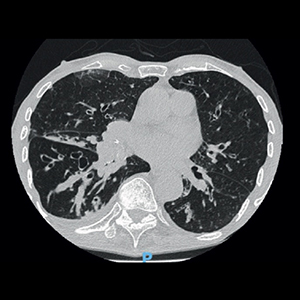Acute and long-term management of severe bronchiectasis with high flow nasal therapy: a case report

Submitted: May 20, 2022
Accepted: August 1, 2022
Published: August 4, 2022
Accepted: August 1, 2022
Abstract Views: 1766
PDF: 647
Publisher's note
All claims expressed in this article are solely those of the authors and do not necessarily represent those of their affiliated organizations, or those of the publisher, the editors and the reviewers. Any product that may be evaluated in this article or claim that may be made by its manufacturer is not guaranteed or endorsed by the publisher.
All claims expressed in this article are solely those of the authors and do not necessarily represent those of their affiliated organizations, or those of the publisher, the editors and the reviewers. Any product that may be evaluated in this article or claim that may be made by its manufacturer is not guaranteed or endorsed by the publisher.
Similar Articles
- Francesca Donati, Leonardo Misuraca, Chrysanthos Grigoratos, Caterina Violo, Stefano Vannucci, Alberto Balbarini, An uncommon clinical condition: chronic thrombosis of the inferior vena cava. A case report and review of literature , Monaldi Archives for Chest Disease: Vol. 74 No. 1 (2010): Cardiac series
- G. Passalacqua, E. Compalati, M. Schiappoli, G. Senna, Complementary and alternative medicine for the treatment and diagnosis of asthma and allergic diseases , Monaldi Archives for Chest Disease: Vol. 63 No. 1 (2005): Pulmonary series
- Madalina Macrea, Richard ZuWallack, Linda Nici, There’s no place like home: Integrating pulmonary rehabilitation into the home setting , Monaldi Archives for Chest Disease: Vol. 87 No. 2 (2017)
- Raj Kumar, Manoj Kumar, Sukriti Raj, Rachna Rachna, Jyoti Mishra, Shyam Mani Dubey, Sourav Kumar, Dileep Kumar Arisham, Gunjan Goutam, Anil Kumar Mavi, Quitting tobacco through quitline services: impact in India , Monaldi Archives for Chest Disease: Early Access
- Joana Almeida Borges, Antonio M. Esquinas, Biphasic cuirass ventilation in the escalation of non-invasive ventilation in COVID-19: Case report and review , Monaldi Archives for Chest Disease: Vol. 93 No. 4 (2023)
- Domenica Di Costanzo, Mariano Mazza, Andreina Carbone, Anna Pratillo, Felice Di Perna, Vittoria Graziani, Cristina Casals Marin, Stefania Tartaglione, Antonio Ponticiello, Retrospective analysis of epidemiologic features and clinical course of COVID-19 patients and comparison between vaccinated and unvaccinated patients , Monaldi Archives for Chest Disease: Early Access
- Amos Lal, Ajay Kumar Mishra, Jamal Akhtar, Christoph Nabzdyk, Pneumothorax and pneumomediastinum in COVID-19 acute respiratory distress syndrome , Monaldi Archives for Chest Disease: Vol. 91 No. 2 (2021)
- Carmine Guarino, Cristiano Cesaro, Giuseppe Fiorentino, Francesco Rossi, Benedetto Maria Polverino, Fiorentino Fragranza, Luca Monastra, Patrizia Murino, Enzo Zamparelli, Giuseppe La Cerra, Bronchoscopy in COVID-19 patients: When, how and why. Experience in clinical practice , Monaldi Archives for Chest Disease: Vol. 91 No. 2 (2021)
- Elpida Skouvaklidou, Ioannis Neofytou, Maria Kipourou, Konstantinos Katsoulis, Persistent unilateral diaphragmatic paralysis in the course of Coronavirus Disease 2019 pneumonia: a case report , Monaldi Archives for Chest Disease: Vol. 93 No. 4 (2023)
- Arturo Cesaro, Carmine Riccio, Paolo Calabrò, Lipid-lowering therapy in high cardiovascular risk patients during COVID-19 pandemic: keep focused on the target , Monaldi Archives for Chest Disease: Vol. 91 No. 2 (2021)
<< < 26 27 28 29 30 31 32 33 34 35 > >>
You may also start an advanced similarity search for this article.

 https://doi.org/10.4081/monaldi.2022.2333
https://doi.org/10.4081/monaldi.2022.2333





